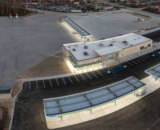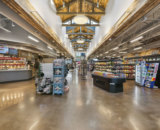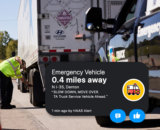The Good to Great Worskshop at NATSO Connect was hosted by Darren Schulte, NATSO (left), Michael Ouimet, Ouimet Consulting Group (center) and Michael Lawshe, Paragon Solutions (right).
During the Good to Great Session at NATSO Connect, the other panelists and I shared our thoughts on what drives traffic through a location. What was interesting was that we all had slightly different ideas. That shows how important it is for operators to really understand who their current customers are and, if they are looking to attract different ones, find the solution that is best for that specific location.
Draw on Demand Purcahses
Michael Lawshe, president of Paragon Solutions, recommends operators use their demand purchases to drive traffic. “No. 1 is your cooler,” he said. “Use the walk-in cooler placement to drive people through the store.”
Lawshe then suggested operators think of what they can sell consumers as they move from the cooler to the register. “If you push it a little deeper, what is an adjacency item you can put there to build the basket,” he said. “If you put the whole store right up front, you’ve really hurt yourself.”
I differ a little on my opinion on the placement of coolers as it relates to the positioning of the transaction counter. I think convenience is key for our hurried interstate customers, and I suggest positioning coolers near or within sight line of the transaction counter versus deeper into the store where it might be hidden by gondola height, collateral and or free-standing fixtures.
I have always been a proponent of placing need items in the back of a store. If people need an item, such as
motor oil or windshield washer fluid, they will ask for it and be willing to walk to get it. With the continued changes that we see with our professional driver community, food on the fast, regardless, if it is sit down, QSR, or grab and go should be the priority with up front placement.
That being said, there is not one magic bullet, thus, as noted above, I think the most important thing is to consider who your customer is. Is it someone who is in a rush? Or do your customers have more time to make their way throughout the location?
Recently I visited one NATSO member that clearly had shoppers and customers spend time wandering the store. They weren’t worried about speed, which means that location may position things differently than a lo- cation where customers want to get in and out quickly.
Consider Cashiers
As part of the session, we also discussed where the transaction counter should be placed, and we had differing opinions. Lawshe felt like placing transaction counter really close to the front of the store short sells the buying cycle. Whereas I and Michael Ouimet, a fellow panelist and owner of Ouimet Consulting Group, felt speed and convenience need to be a priority, which means putting the transaction counter closer to the front.
Ouimet went on to say that he considers the impact of labor on business and focuses on maximizing his staff’s time when determining product placement, location layout and traffic flow.
Tap into Data
One way to help determine how to layout your store and position products is to draw on data. Everybody wants more data. Big retailers spend tens of millions of dollars to decide what should go on an endcap. While we don’t have those types of funds, you can look at your own numbers to identify your top selling items or destinations. We all have data and in most cases more data than we will actually ever use. So start with what you currently have, the data that allows you to understand what is true and then build on it. Once you have that information, you can think through where you should place your products.
For example, do you know if customers are using your ATM? If they are, why not consider positioning it in an unproductive area of your store? Your push back may be that positioning it in the front increases usage, which converts into sales. Again, just verify if this is factual versus your gut by properly observing the usage over a period of time. Is lottery a demand driver? If so, using Lawshe’s idea of demand positioning, consider positioning the scratch off ticket lottery machine in the back of your store.
Remember your partnership with your vendors. Talk to them. They can offer insight into what would work best on your counter or an endcap. Your vendors can also support you with their displays. Are they just dropping 30 cases of beer and putting a sign on it or are they building product displays that are focal points within your store with proper right wrap, collateral, sight lines, etc.?
By taking a multi-pronged approach and looking at your high- and low-performing areas as well as product sales and customers’ needs, you can create the best format for your store to drive sales.
Photo credit: Brittany Palmer/NATSO
Subscribe to Updates
NATSO provides a breadth of information created to strengthen travel plazas’ ability to meet the needs of the travelling public in an age of disruption. This includes knowledge filled blog posts, articles and publications. If you would like to receive a digest of blog post and articles directly in your inbox, please provide your name, email and the frequency of the updates you want to receive the email digest.


